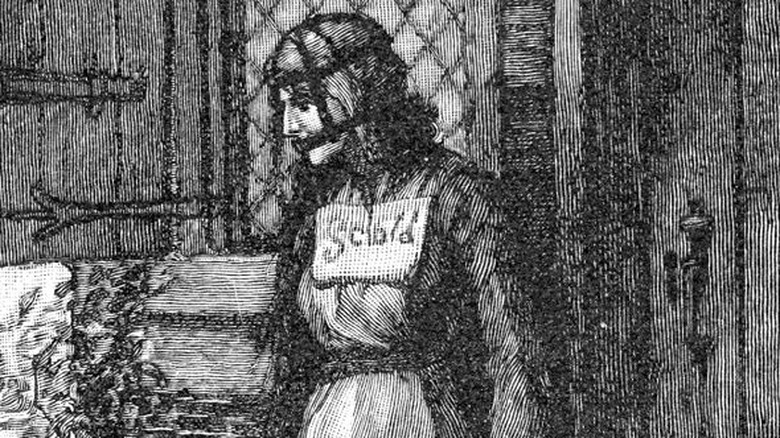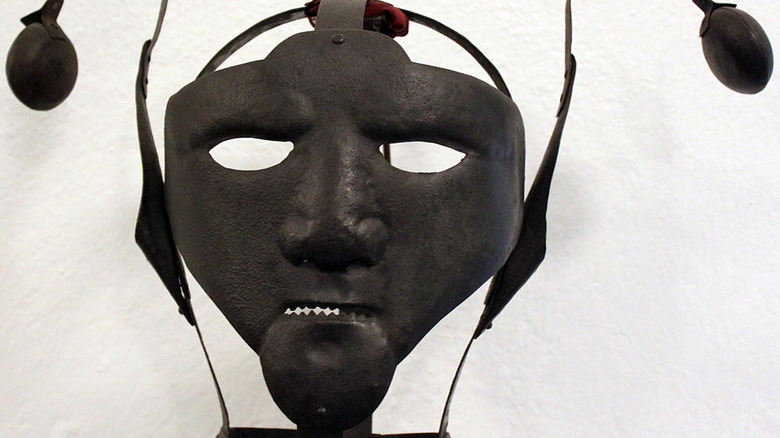The Horrible Medieval Weapon That Was Used To Torture Wives
The Middle Ages were a dark time when brutality ruled and things like torture were considered acceptable enough, depending on the circumstances. It was not uncommon for torture to be used to get information and force confessions, from the innocent as well as the guilty. Its threat was a tool to scare people into submission, and utilized as a tool for hatred and revenge (via Medieval Warfare).
Middle Ages torture methods varied from "unsurvivable" practices — mutilation, dislocating joints, or even disemboweling — to those that were meant to humiliate and make people repent for their behavior. Pillories in general — where a wooden frame would be placed around the neck, hands, and sometimes feet–– were a common form of public shaming device and one that encouraged aggression from the public, who often had fun throwing things at the defenseless victims (via Londonist). While some forms of torture and shame were reserved for criminals, many of the forms of abuse and torture common in the Middle Ages were just as likely to be used on those accused of minor "crimes," whose punishment included shaming.
Women didn't enjoy a significant place in society for much of ancient history, but by the Middle Ages, lower-class women often had a job that helped support the family. According to World History, they were anything from bakers and artisans to farmers, but they were only so as part of the family unit.
Some torture devices were mainly used on women
On their own, women weren't allowed to own land or property, and once married, their main job would be child-bearing. They were subordinate to their husbands, whom they were required to honor and obey (via World History). Women who didn't fit into the accepted mold were often brutally punished and shamed publicly. This was sometimes requested by the husband himself, who couldn't afford to let his wife "run wild" and shame him in the process. "Crimes" included nagging their husbands, disturbing the peace, or talking back when scolded. In England this behavior classified the offending wife as being a scold or shrew and it was actually illegal (per The Week).
Known as a witch's bridle or branks (after a type of halter used for horses), the 17th century scold's bridle was primarily meant to humiliate rather than cause pain to the person wearing it. That's not to say this iron muzzle was comfortable. It consisted of an iron frame or cage that enclosed the head, sometimes with an added mask that covered the entire face, as described via BBC. A piece of metal known as a bridle-bit extended into the mouth, pressing the tongue and preventing the person from speaking.
According to the National Education Network, the main purpose of the scold's bridle was to "curb women's tongues that talk so idle." It was mainly used on women, meant to keep them from gossiping, using inappropriate words, or embarrassing their husbands.
The scold's bridle has a dark history
There are stories here and there about the bridle being used on men, such as the case where a prisoner was bridled in prison so he would stay quiet until his execution (via Lancaster Castle). But the bridle was mostly used to punish women who wouldn't behave according to the socially appropriate standards of the time.
A century earlier, it was used, mainly in Scotland, to torture women accused of witchcraft. Instead of a single piece of metal holding down the tongue, those bridles had sharp spikes that went into the mouth and would pierce the tongue or cheeks (via Lancaster Castle). This was extremely painful and it was often kept in place until the accused witch was executed.
More commonly, the scold's bridle was a form of public shaming. Its use was sometimes paired with a the 'Ducking Stool," which was like a see-saw; the victim would be strapped into a chair at one end, and then lowered into a pond or stream. This was meant to serve as both punishment and a form of public humiliation, as passersby could yell, insult, or throw things at the woman on the chair (per Encyclopedia).
The scold's bridle continued to be used, though less frequently, until the late 1800s. Widows, unmarried, or older women would often end up as victims, as they were considered a threat to the moral and social standing of a town, according to Lancaster Castle. It wasn't until the Victorian Era, characterized by a more moderate view of punishments, that the device was abolished as barbaric and old-fashioned.


